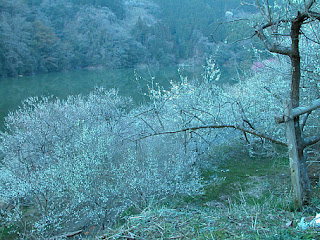The shrines called Tenman-gu(or tenjin) enshrine Sugawara Michizane(菅原道真,845-903) . He loved ume blossoms, so the shrine crest of tenman-gu is a ume blossom.
Many ume trees have yet to bloom, but they are likely to bloom this week.
 |
| Kitano Tenman-gu Shrine(北野天満宮) in Kyoto on March 9, 2006 photo by 高画質壁紙写真集無料壁紙 |
Many tenman-gu shrines hold Ume Blossom Festival(Baika-sai, 梅花祭) on February 25th because he died on the 25th day of the second lunar month (on March 26th according to the Julian calendar) in 903.
 |
| Sone Tenman-gu Shrine(曽根天満宮) in Hyogo Prefecture photo by 神戸観光壁紙写真集 |
 |
| Tobi-ume at Dazaifu Tenman-gu in Fukuoka Prefecture Photo by Yokaphoto.net |
東風吹かば にほひおこせよ 梅の花
あるじなしとて 春を忘るな
"ume blossoms, when the wind is in the east, carry the smell of you all the way to me on the wind. even if I'm not here, never forget to bloom in spring."
 |
| Tobi-ume at Dazaifu Tenman-gu in Fukuoka Prefecture Photo by Yokaphoto.net |
 |
| ume blossoms and statue of ox at Kitano Tenman-gu Shrine(北野天満宮) in Kyoto on March 9, 2006 photo by 高画質壁紙写真集無料壁紙 |
 |
| Kitano Tenman-gu Shrine(北野天満宮) in Kyoto on March 9, 2006 photo by 高画質壁紙写真集無料壁紙 |
 |
| Kitano Tenman-gu Shrine(北野天満宮) in Kyoto on March 9, 2006 photo by 高画質壁紙写真集無料壁紙 |
 |
| Kitano Tenman-gu Shrine(北野天満宮) in Kyoto on March 9, 2006 photo by 高画質壁紙写真集無料壁紙 |
However, he continued Michizane's efforts to promote political and economic reform and enacted a law to prevent powerful aristocrats including Tokihira himself from increasing private properties.
As a result, his economic reform was not very effective because he adhered fundamentally to the exsiting system.
 |
| Kitano Tenman-gu Shrine(北野天満宮) in Kyoto on March 9, 2006 photo by 高画質壁紙写真集無料壁紙 |
 |
| Kitano Tenman-gu Shrine(北野天満宮) in Kyoto on March 9, 2006 photo by 高画質壁紙写真集無料壁紙 |
Ancient Japan had no writing system, so an ancient writing system employed Chinese characters to represent the Japanese language.
Each Chinese character represents a single syllable, but it needs many brushstrokes.
Kana (hiragana and katakana, both Japanese syllabary characters) were created by simplifying Chinese characters to be written faster in the 9th century.
 |
| Sone Tenman-gu Shrine(曽根天満宮) in Hyogo Prefecture photo by 神戸観光壁紙写真集 |
The characters were regarded merely as the simplified forms of Chinese characters. So kana was as sort of a subculture that was mainly used by female and lower-class male aristocrats. Most of the high-level male aristocrats used Chinese characters that were approved as official ones.
Tokihira received Imperial command to compile the first anthology of poems. He ordered some middle and lower class bureaucrats including Ki no Tsurayuki(紀貫之) to compile Kokin Wakashu(A Collection of Ancient and Modern Japanese Poetry) written in Chinese and kana characters.
This anthology led Kana characters to become more popular and part of mainstream culture, and it paved the way for the rise of female writers such as Murasaki Shikibu(紫式部), Sei Shonagon(清少納言).
If flower was mentioned in those days, it would remind nobles of ume blossom. Ume came from China and its blossom was a flower that symbolized China.
However, flower came to mean cherry blossom in Japan in the middle of the Heian Period when the Chinese culture became less influential and an indigenous culture developed in every aspect.
Tokihira made no attempt to reach the highest position of power called Sessho kanpaku(regent and chief adviser to the Emperor). His younger brother Tadahira obtained real political power after he died at the age of 39, and it was transmitted to Tadahira's descendants. Tokihira's descendants were not promoted.
There was a rumor circulating that his early death was attributed to the curse of Michizane's vengeful spirit. He has been portrayed as the villain hostile to Michizane.
Chinese characters were used in the Chinese, Japanese, Korean and Vietnamese languages. Vietnam abolished Chinese characters from its language in 1954. In Korea, Chinese characters are used at a low frequency. Korean people use Hangul(Korean phonetic characters) on a daily basis. Unlike Japan, Hangul was promulgated by Sejong the Great(the fourth king of the Joseon Dynasty of Korea) in 1466.































